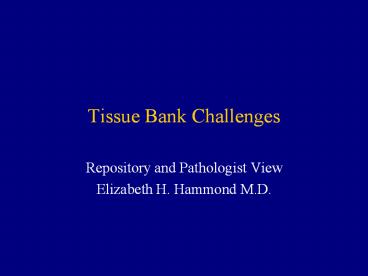Tissue Bank Challenges - PowerPoint PPT Presentation
Title:
Tissue Bank Challenges
Description:
Repository and Pathologist View. Elizabeth H. Hammond M.D. ... Pathologists who provide tissue to banks. Repository Manager Challenges. Confidentiality ... – PowerPoint PPT presentation
Number of Views:218
Avg rating:3.0/5.0
Title: Tissue Bank Challenges
1
Tissue Bank Challenges
- Repository and Pathologist View
- Elizabeth H. Hammond M.D.
2
2 Types of Challenges
- Repository managers
- Pathologists who provide tissue to banks
3
Repository Manager Challenges
- Confidentiality
- Tissue Accuracy
- Specimen Tracking
- Consent Tracking
- Specimen Disposition
- Which IRB?
4
Confidentiality
- Limited access to identified information
- Confidentiality agreements
- Security of identified information
- Retention of identified information
- Tracking of disclosure of information
5
Tissue Sample Accuracy
- Tissue samples and associated identifying
information must be used to insure that samples
received - Represent tissue of study patient
- Contain tissue of interest to the study
- Do not contain artifacts which render tissue
unusable for research
6
Specimen Tracking
- Sample identification
- Sample storage and retrieval
- Tracking of samples to/ from investigators
- Tracking of samples back to institutions
- Tracking of sample disposal
7
Consent Tracking
- Samples with/without consent
- Level of consent
- Patients decreased (with documentation)?
- Tracking of consent when samples used
- Sample reuse beyond study definition
8
Specimen Disposition
- Sample tracking/ retrieval to insure prompt
return of samples - Sample disposition when block expended
- Sample disposition when study closed
9
IRB Jurisdiction
- Which IRB has ethical oversight for the
repository? - Which IRB has ethical oversight when a study
using tissue is approved by clinical trial group
or other entity?
10
Repository Approaches
- Tracking issues require data bases
- Identified information must be secured and
dispostion must be controlled by policy - Data base security and access must be carefully
controlled - Local IRB coordinated approach to HBM issues must
be arranged to insure uniform education about
policies
11
Pathologist Challenges
- Patient Care
- Patient Consent
- Cost
- Malpractice Risk
- Ownership/credit
12
Patient Care
- Blocks may be needed for future clinical tests
(Her2 in breast cancer) - Retrospective review of samples when new risk
factors found, new diagnoses considered - Late requests for second opinions
13
Patient Consent
- What documentation should be requested?
- How should consent information be recorded?
- Institutional policies are highly variable as are
the wishes of IRBs.
14
Issue of Cost
- Pathologists are busier with smaller staffs
- Block selection for tissue banking is time
consuming (expensive) - Reports, blocks, and slides must be obtained
- Report and slides must be reviewed
- Block must be selected and shipped
- Documentation must be maintained
15
Issue of Malpractice Risk
- Retention of slides or blocks beyond the times
mandated by regulatory agencies may be seen as
promoting malpractice risk. - Can be used in litigation longer
- Can be reviewed and diagnosis challenged
- Policy must be specific and documented or patient
can challenge removal of tissue from department
which may promote litigation
16
Issue of Ownership
- Pathologists view blocks are potential valuable
resource for own research. - Issues of ownership vary by state
- Ownership becomes bargaining issue
17
Approaches to Patient Care Issues
- Uniform guidelines for tissue retention for
patient care are needed that are not state
specific and are widely endorsed and enforced by
regulatory agencies such as CAP/JCAHO. - Tissue requirements must be mindful of potential
patient care needs (retention of unstained slides
or availability of rapid return of materials when
necessary)
18
Patient Consent Approaches
- Uniform consent form should be provided or
education about key elements - Process to assure proper procedures are followed
should be available and simple - Documentation guidelines or forms should be
created/provided (?web based) - Information should be available to pathologists
to enable understanding of process
19
Approaches to Cost
- Mechanisms to provide payment and ease of
submission/shipment of materials are needed. - Uniformity of submission requirements would be
helpful. - Strategies for case identification are needed
which are not disruptive to patient care
20
Malpractice Risk Approaches
- Pathologists should be informed about the value
of standardized procedures and documentation in
preventing malpractice risk - Policies should be developed for situations of
discrepant diagnoses which mitigate against
malpractice risk
21
Approaches to Ownership Issues
- National guidelines are needed for determining
ownership or establishing priority of granting
tissue requests. - Strategies for giving credit to pathologists for
participation are needed which they accept. - Access to tissue resources could be enabled for
those providing tissue so that individual studies
could be done.
22
Public Education
- Public opinion could be marshaled to promote
tissue acquisition by publicizing results of
studies where cooperation led to important new
treatment strategies. - Patient advocacy groups and oncology groups could
promote tissue banking using media and individual
pathologist contact.
23
Pathologist Cooperation
- Participation of all types of pathologists in
creating solutions will promote cooperation. - Involvement of pathology organizations as
resources for information and guideline
development will foster support. - Communication about the impact of tissue banking
on future cancer care will promote cooperation.































